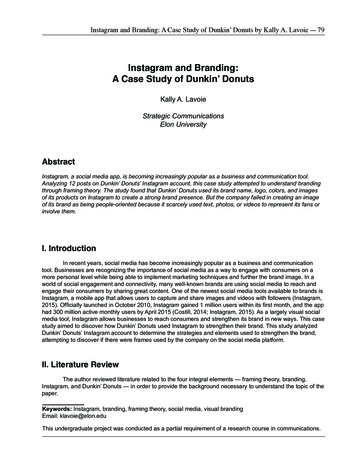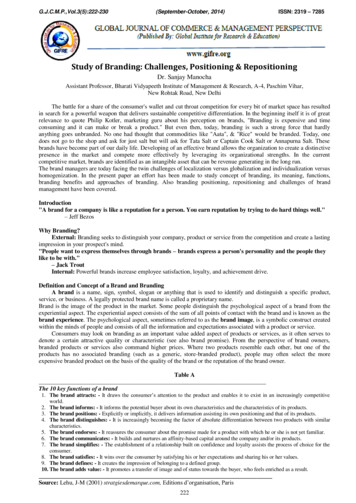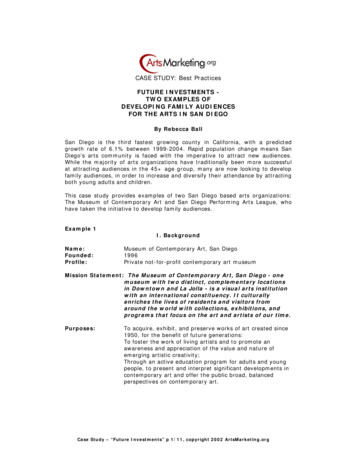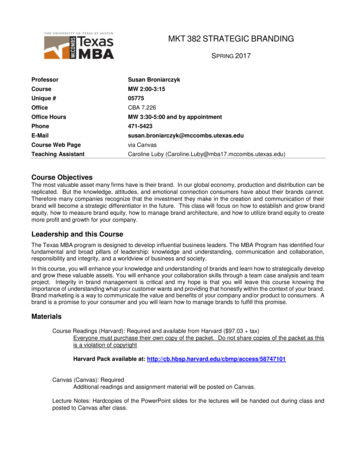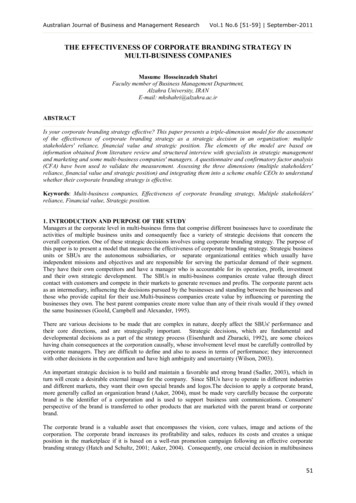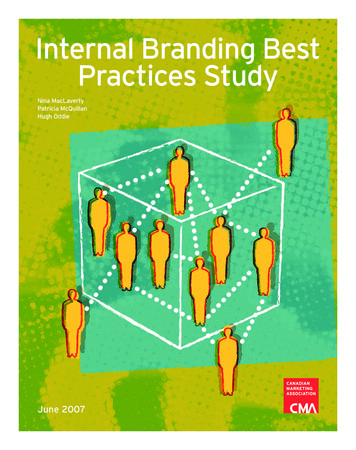
Transcription
38170 CMA White Cover15/7/078:18 AMPage 1Internal Branding BestPractices StudyNina MacLavertyPatricia McQuillanHugh OddieJune 2007
Internal Branding Best Practices StudyAcknowledgmentsSpecial thanks to the following organizations for contributing to the qualitative researchsupporting this study:American ExpressGenworth Financial CanadaIKEARoyal Bank of CanadaSears CanadaStarbucks CanadaTD Canada TrustTim Horton’sUnion EnergyUnited WayWorld VisionWe also would like to acknowledge the support of the Executive Committee of CMA’sBranding and Strategic Planning Council who first identified the need for research intobrand metrics practices in 2004, in particular, Bob Humphreys for steering the Council’sinitial research. Numerous CMA members have participated on the Council’s ExecutiveCommittee since then, sharing their expertise and insights, and discussing internal brandingas an important discipline. Without their support, our Internal Branding Best PracticesStudy would not have been possible. Canadian Marketing Association 2007
Internal Branding Best Practices StudyTABLE OF CONTENTSSection 1: Executive Summary . 11.1 Background. 11.2 Summary of Findings. 11.3 Implications. 1Section 2: Methodology . 2Section 3: Internal Branding Defined. 2Section 4: Leadership . 3Section 5: Key Challenges. 5Section 6: Implementation . 66.1 Internal Branding Techniques and Tools . 66.2 Additional Observations. 86.3 Further Research. 8Section 7: Measurement . 87.1 What is measured?. 87.2 Internal Branding Measurements . 9Customer Metrics. 9Employee Measurement . 10Appendix . 11About Canadian Marketing Association. 11Author Biographies . 11 Canadian Marketing Association 2007
Internal Branding Best Practices Study1. Executive Summary1.1 BackgroundDuring the spring of 2005, the CMA Branding and Strategic Planning Council identified aneed to delve deeper into Internal Branding, one of the top issues identified by Canadianmarketers. The Council began its research into internal branding with an online survey thatexamined how organizations view and implement internal branding practices. The results,subsequently published in CMA’s 2006 Fact Book, have since been supplemented withadditional research. Together, they are presented in this white paper, ‘Internal BrandingBest Practices Study.’1.2 Summary of FindingsInternal branding is a relatively new approach practiced by the companies of leadingCanadian brands. Given the newness of this area, it was not surprising to find that itsapplication is relatively inconsistent across participating organizations. This emerging areaof brand management presents significant opportunity to the Canadian service industry withthe ability to be more attentive to branding and customer promise development. Internalbranding also facilitates more consistent delivery.1.3 ImplicationsThe successful implementation of the “Internal Branding Best Practices Study” can build thebridge between strategy and execution. Significant improvements to customer experienceand loyalty ratings can be achieved once this connection is made, assuming that anorganization’s brand promise is well researched and meets current customer needs. Canadian Marketing Association 20071
Internal Branding Best Practices Study2. MethodologyThis Canadian Marketing Association’s internal branding best practices study is based onboth qualitative and quantitative research methods. The qualitative research consisted ofeleven in-depth phone interviews conducted from July to December 2006 with executivesthat are responsible for internal branding within their organizations. Contributingorganizations are listed on the Acknowledgment page of this paper and are sincerelythanked for their candid and thoughtful input. The quantitative research portion of this studywas managed through a CMA 2005 Internet survey of 475 respondents across industries.The CMA Branding and Strategic Planning Council provided additional input to this study inorder to reflect cross-industry experience and other recent complimentary CMA researchstudies.3. Internal Branding DefinedCommonly accepted definitions of either “brand” or “internal branding” could not be found inany of the research that has been undertaken to date.The definition of brand has become a customer experience based concept.1 Therefore, it isnot surprising that businesses are looking for ways to ensure that the brand experience isdelivered in a way that stays true to the brand promise. But staying true to the brandpromise is easier said than done. Senior management typically develops brand strategywhile the actual brand experience is most often delivered by the least-informed and lowestpaid service associates. Also, to further complicate matters, these front line associates areoften part-time. Best practices in internal branding can build that crucial bridge betweenstrategy and execution.In 2005, the CMA surveyed marketers about their organization’s internal branding activities.Internal branding was described within the survey as “promoting the company brand valuesamongst employees.” In 2006, qualitative interviews were conducted with senior marketersacross all business sectors. These in-depth interviews revealed an expanded concept ofinternal branding.2While many companies do not use the words internal branding, all of the interviewees wereable to describe the activities that build the bridge between strategy and execution. Theyused expressions such as: Living the corporate values.Leveraging the corporate brand strategy to reinforce brand requirements internallyand reach out to potential recruits externally.Activities, processes and communication involved in empowering associates.Create and demonstrate consistent brand experience at all touch points.1In 2004 the CMA undertook a project to gain an understanding of how companies measured “Brand”. This wasboth a qualitative and quantitative study, the results published in “Today’s Brand Measurement: The Integrationof Perceptions, Behaviours & Environments,” 2004.2The respondents included 10 senior marketers and one human resource professional.2 Canadian Marketing Association 2007
Internal Branding Best Practices StudyBased on these interviews and additional reading we would suggest the following definitionfor ”internal branding”:Internal branding is the set of strategic processes that align and empower employeesto deliver the appropriate customer experience in a consistent fashion. Theseprocesses include, but are not limited to, internal communications, training support,leadership practices, reward & recognition programs, recruitment practices andsustainability factors.Given the depth of information gathered through the qualitative research, this definition hasbeen expanded with an inventory of best practices falling under each of the processesdefined, as outlined in Section 6: Implementation.4. LeadershipWho is in charge of internal branding?In the research, there was not one company that had expressly dedicated one individual'sresponsibilities to “internal branding". More often than not, it was one of a laundry list ofresponsibilities in a marketing executive's mandate, parked alongside the responsibilities ofadvertising, branding, direct marketing, merchandising, etc. One of the reasons for this lackof clear responsibility is the cross functional nature of the task. This responsibility wasusually delegated to the marketing department in general. The logic for it being part of themarketing department's role is that the marketing department is the most involved in theinteraction between company and customers. Thus, following on from the definition, it isthis functional unit that needs to join company brand with customer experience.The CMA Internal Branding Research Survey of 2005 confirms that the responsibility forinternal branding resides within the purview of marketing:Development of internal branding strategies tends to be shared by the marketinggroup and executive team with more than one-quarter mentioning internal brandingas a marketing responsibility and 72% stating that the executive team holds someresponsibility. External agencies are utilized by one in five of the companiessurveyed. Canadian Marketing Association 20073
Internal Branding Best Practices StudyAREAS WITHIN YOUR ORGANIZATION RESPONSIBLEFOR DEVELOPING INTERNAL BRANDING STRATEGIESMarketing77Executive team72Human Resources41Public relations28External agency21Other11020406080100percentageWhen asked if these were the same groups responsible for external branding strategies,almost six in ten companies (59%) suggested that the same groups build internal andexternal branding strategies.Even if internal branding is nominally anchored in the marketing function, it is clear that bothhuman resources and the executive team need to be intimately involved with internalbranding initiatives.Notwithstanding the fact that the leadership for internal branding might be anchored in onefunctional unit, it is vital to note the importance of the role of all management to "walk thetalk" and the apparent lack of them actually doing so. Only 22% of respondents in the CMAsurvey strongly agree with the statement "management walks the talk with respect to brandvalues." Clearly there is a need for senior executives to demonstrate that it is “they who arein charge,” i.e. Leadership. In fact, this desired senior management behaviour is includedwith the list of internal communications best practices in Section 6: Implementation. TheImplementation Table demonstrates that this critical component of senior managementshould be formalized and rewarded in best practice organizations.Overall, as a best practice, responsibility for strategic development and implementation forinternal branding should be vested clearly with one senior level individual or group ofindividuals who have wide reach and access across functions. They also should bemeasured and rewarded for their success in this key area of brand management.4 Canadian Marketing Association 2007
Internal Branding Best Practices Study5. Key ChallengesWhat are the challenges for internal branding?There was a consensus amongst several of the companies participating in the research thatthe overarching challenge for internal branding is how to translate the company's brandvalues into physical employee behaviours. In order to achieve this objective, companiesemploy a plethora of implementation techniques, which will be explored in the next section.The breakdown of the key challenges from the CMA survey is as follows:KEY CHALLENGES OF INTERNAL BRANDING15Communicati on12Consi stency9Getting Buy-In8Getting E xecutive/Seni or Commitment5Ti me AvailabilityCulture4Organizational Structure44A rticulating Relevance of Internal Brandi ng3Prioritizing Internal Brandi ng2Budget11Measuring E ffectivenessDefining Brand Values/Essence3Other32Did Not Answer010203040pe rce ntag e of men tion sOne of the major challenges inhibiting the success of this translation is that internalbranding touches marketing, human resources, brand management, operations,front line management and strategy. Several of the best practice companies havecome close to overcoming these functional silos in their internal branding efforts.Nevertheless, for most companies, the inability to cross the boundaries betweendivisions fluidly in internal branding efforts presents a major challenge.The lack of alignment between employees’ values and company values emerged asa challenge from the CMA survey: "The low proportion (7%) of respondents whothink their brand values provide guidance as to how to treat other employeessuggests that brand values do not address human interrelationships in a meaningfulway." Canadian Marketing Association 20075
Internal Branding Best Practices StudyInterestingly, several companies that have found "keeping the momentum going" to be areal challenge were identified in the qualitative research. Since involving themselves in avariety of communication and employee involvement initiatives, their challenge is "whatnext?"Finally, and
FOR DEVELOPING INTERNAL BRANDING STRATEGIES 77 72 41 28 21 11 0 2040 6080 100 Marketing Executive team Human Resources Public relations External agency Other percentage When asked if these were the same groups responsible for external branding strategies, almost six in ten companies (59%) suggested that the same groups build internal and external branding strategies. Even if internal branding .





